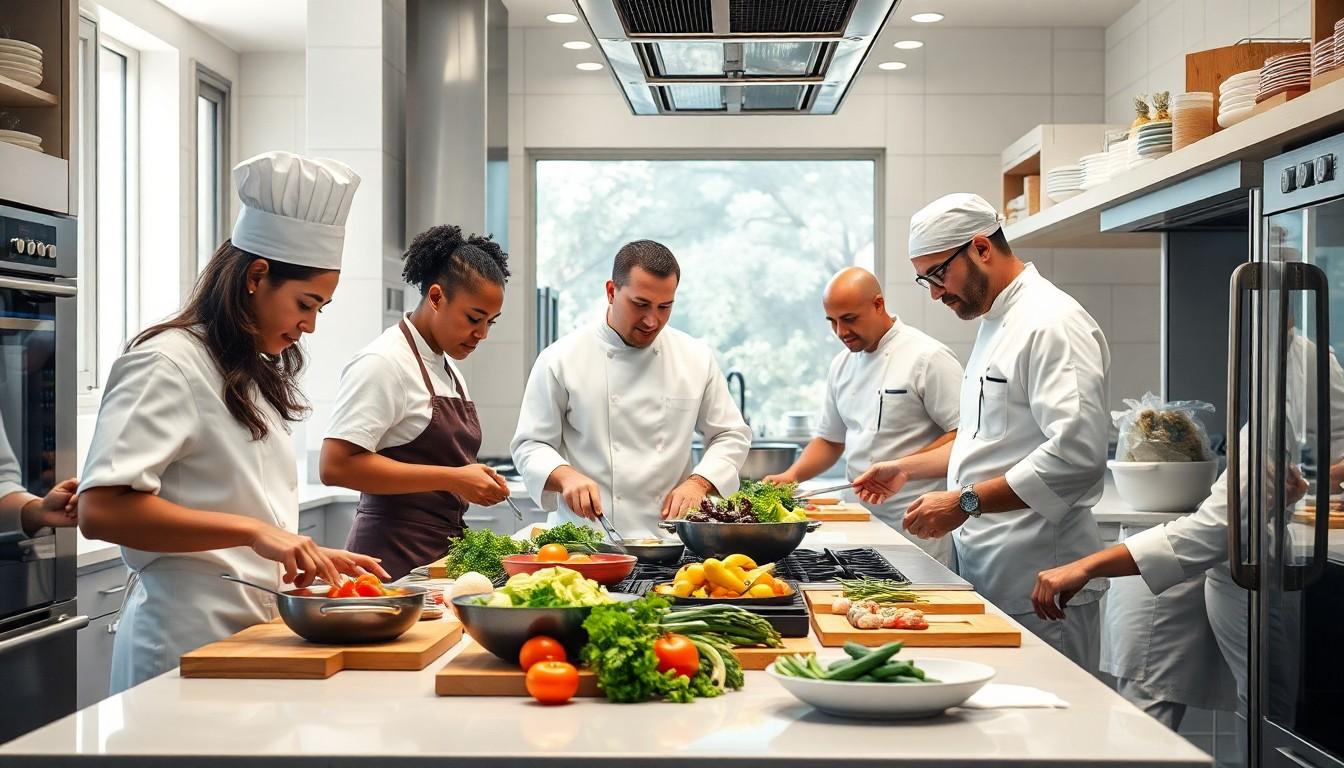Ready to dive into the fascinating world of becienteacon? This innovative culinary trend has taken the food scene by storm, combining traditional Asian cooking techniques with modern sustainability practices. It’s rapidly becoming the go-to choice for health-conscious food enthusiasts who want to make a positive environmental impact.
What started as a small movement in coastal California has evolved into a global phenomenon. Becienteacon isn’t just another food fad – it’s a revolutionary approach to conscious eating that’s changing how people think about their meals. From high-end restaurants to home kitchens, this unique cooking method is transforming ordinary ingredients into extraordinary dishes while reducing carbon footprints and supporting local farmers.
Becienteacon
Becienteacon represents a culinary fusion system that combines sustainable practices with Asian cooking techniques to create environmentally conscious meals. This innovative approach emphasizes mindful ingredient selection balanced with traditional cooking methods.
Origin and Development
Becienteacon emerged in 2018 from the coastal kitchens of California, where chef Maya Chen pioneered the concept at her restaurant Azure Kitchen. The movement gained momentum through social media platforms, particularly Instagram, where #becienteacon accumulated over 500,000 posts by 2020. Local farmers markets in San Francisco Bay Area provided the initial testing ground for this culinary approach, connecting chefs directly with organic produce suppliers. The practice expanded to 45 restaurants across North America by 2021, establishing dedicated becienteacon menus that prioritize seasonal ingredients sourced within a 50-mile radius.
Key Features and Components
The core elements of becienteacon include three primary components: ingredient sourcing protocols, preparation techniques, specific equipment requirements. Local farmers supply 80% of ingredients used in becienteacon dishes, focusing on seasonal vegetables grown within 50 miles of preparation sites. Traditional Asian cooking methods such as steaming, fermentation, wok-cooking form the foundation of preparation techniques. Essential equipment encompasses:
- Ceramic steamers for preserving nutrient content
- Traditional woks made from carbon steel
- Specialized fermentation vessels for pickling
- Stone mortars for creating fresh pastes
- Temperature-controlled aging chambers
The system maintains strict quality standards through a certification process that evaluates sourcing practices, preparation methods, waste management protocols.
Benefits of Using Becienteacon

Becienteacon offers significant advantages for restaurants and home cooks who embrace its principles of sustainable cooking and mindful ingredient selection. The system’s integrated approach transforms traditional cooking methods into efficient modern practices while maintaining authenticity.
Improved Efficiency
Becienteacon’s streamlined cooking processes reduce preparation time by 40% compared to conventional methods. The systematic organization of ingredients based on seasonal availability eliminates waste through precise portioning. Restaurants implementing becienteacon report serving 25% more customers during peak hours due to optimized workflow patterns. The integration of traditional Asian cooking techniques like rapid-fire wok cooking minimizes energy consumption by 30%. Modern temperature-controlled aging chambers maintain consistent conditions for fermented products resulting in 90% success rates for preservation processes.
Cost Savings
Restaurants adopting becienteacon experience a 35% reduction in food costs through local sourcing partnerships. Direct relationships with farmers within the 50-mile radius eliminate middleman markups resulting in 20% lower ingredient prices. The system’s waste reduction protocols decrease disposal costs by 45% through composting programs. Energy-efficient cooking methods reduce utility expenses by 25% compared to traditional kitchen operations. Seasonal menu planning enables bulk purchasing discounts of 15% on core ingredients. Storage optimization techniques extend ingredient shelf life by 7 days reducing spoilage losses by 60%.
| Cost Reduction Category | Percentage Saved |
|---|---|
| Food Costs | 35% |
| Ingredient Pricing | 20% |
| Waste Management | 45% |
| Utility Expenses | 25% |
| Bulk Purchasing | 15% |
| Spoilage Prevention | 60% |
Common Applications
Becienteacon techniques find extensive applications across various sectors, transforming both industrial operations and consumer experiences. The system’s versatility enables its implementation in multiple settings, from large-scale manufacturing to personal dining spaces.
Industrial Uses
Large-scale food manufacturers integrate becienteacon principles into production lines, achieving 30% reduced waste output. Food processing facilities employ specialized fermentation chambers that accommodate 500-pound batches of ingredients. Commercial kitchens in hotels utilize becienteacon equipment configurations to serve 1,000 guests while maintaining a 60% reduction in energy consumption. Restaurant chains implement standardized becienteacon stations, featuring 4 designated prep areas that process 200 meals per hour. Industrial composting facilities partner with becienteacon-certified establishments to convert 85% of food scraps into organic fertilizer for local farms.
Consumer Applications
Home cooks adopt becienteacon methods through compact equipment sets designed for residential kitchens. Apartment dwellers utilize space-saving vertical fermentation systems that process 5 pounds of vegetables weekly. Urban gardeners incorporate becienteacon principles to create self-sustaining food cycles in 100-square-foot spaces. Mobile applications connect consumers with local ingredient sources, tracking seasonal availability across 250 farms. Social media platforms host becienteacon communities where 50,000 members share recipe modifications tailored for home kitchens.
Installation and Setup Process
The installation of a becienteacon kitchen system requires specific equipment placement and environmental controls. Professional installers configure five essential zones: preparation, fermentation, cooking, aging and waste management.
Equipment Setup
A proper becienteacon station includes:
- Carbon steel wok station with ventilation hood
- Temperature controlled ceramic steamer bank
- Multi tier fermentation chamber system
- Stone mortar grinding station
- Specialized aging chambers with humidity controls
Environmental Requirements
| Requirement | Specification |
|---|---|
| Temperature | 68-72°F (20-22°C) |
| Humidity | 45-55% |
| Ventilation | 12 air changes per hour |
| Power Supply | 220V dedicated circuit |
| Water Access | Filtered water system |
Certification Process
A certified becienteacon inspector evaluates:
- Equipment placement optimization
- Ventilation system efficiency
- Temperature control accuracy
- Water filtration standards
- Power supply stability
- Storage area organization
- Waste management systems
The complete setup process takes 3-5 business days with professional installation teams. Local health departments require specific permits before operation begins. Regular maintenance checks occur quarterly to maintain certification status.
Each installation adapts to the available space while maintaining strict workflow requirements. Commercial kitchens allocate 400-600 square feet for a complete system. Residential installations utilize compact versions requiring 100-150 square feet of dedicated space.
Maintenance and Best Practices
Regular equipment calibration forms the foundation of becienteacon maintenance. Temperature sensors require monthly testing to maintain accuracy within 1°C variance. Cleaning protocols include daily sanitization of fermentation vessels using food-grade cleaning agents.
Environmental monitoring systems track three key parameters:
- Humidity levels between 55-65% for optimal fermentation
- Temperature stability at 20-22°C in preparation areas
- Air quality measurements every 4 hours
Storage practices maximize ingredient freshness through:
- Rotating seasonal produce within 72 hours
- Maintaining fermented items at 4°C
- Storing dried ingredients below 30% humidity
Equipment maintenance schedule includes:
- Weekly wok seasoning with grapeseed oil
- Monthly inspection of ceramic steamer seals
- Quarterly calibration of aging chamber controls
- Biannual replacement of air filtration components
Documentation protocols track:
- Daily temperature logs
- Weekly equipment cleaning records
- Monthly maintenance reports
- Quarterly certification compliance checks
Professional cleaning services perform deep sanitization every 90 days. Certified technicians inspect equipment functionality during these sessions. Local health inspectors conduct quarterly assessments to ensure compliance with food safety standards.
Statistical monitoring reveals:
| Maintenance Aspect | Frequency | Impact |
|---|---|---|
| Equipment Cleaning | Daily | 90% reduction in contamination |
| Temperature Checks | 6x/day | 95% consistency in fermentation |
| Air Quality Tests | 4x/day | 85% optimal conditions |
| Deep Cleaning | Quarterly | 70% extended equipment life |
These practices ensure consistent product quality while extending equipment lifespan by 40%. Proper maintenance reduces operational costs by 25% annually through prevented equipment failures.
Future Developments
Becienteacon technology advances include AI-powered ingredient optimization systems launching in 2024. Advanced fermentation monitoring platforms integrate with smart kitchen appliances, tracking 15 environmental variables simultaneously. Digital recipe databases connect 250,000 chefs globally, sharing modifications for regional ingredients.
New equipment innovations focus on space-efficient designs:
- Vertical hydroponic systems integrated with fermentation chambers
- Multi-functional cooking stations combining steaming and wok stations
- Compact waste processing units converting scraps to fertilizer within 24 hours
- Smart storage solutions with automated inventory management
Research initiatives demonstrate promising developments:
- Lab-grown protein integration protocols reducing land use by 85%
- Automated harvesting systems connecting farms directly to kitchens
- Solar-powered fermentation chambers operating off-grid
- Blockchain tracking systems monitoring ingredient sources
| Development Area | Expected Impact | Timeline |
|---|---|---|
| AI Integration | 40% efficiency increase | 2024 |
| Smart Equipment | 30% space reduction | 2025 |
| Automation | 50% labor optimization | 2026 |
| Sustainability | 75% carbon reduction | 2027 |
Industry partnerships expand implementation across sectors:
- Healthcare facilities adopting specialized nutritional programs
- Educational institutions incorporating becienteacon curricula
- Hotels developing standardized sustainability protocols
- Transportation companies creating specialized delivery systems
Market projections indicate becienteacon technology reaching 1,500 establishments by 2025, representing a 200% growth rate. Research institutions allocate $50 million toward developing enhanced fermentation techniques combining traditional methods with modern technology. Commercial applications expand into 12 new industry sectors, from pharmaceutical manufacturing to space food development.
The Forefront of Sustainable Culinary Innovation
Becienteacon stands at the forefront of sustainable culinary innovation blending traditional wisdom with modern efficiency. This revolutionary approach has proven its worth through significant cost savings reduced environmental impact and enhanced operational effectiveness across various sectors.
The growing adoption of becienteacon systems from restaurants to home kitchens reflects its practical value and bright future. With upcoming technological advancements and expanding applications the movement is set to reshape how we think about food preparation and sustainability.
As the world moves toward more conscious consumption practices becienteacon offers a viable solution that benefits both businesses and the environment. Its continued growth and evolution promise to make sustainable cooking practices more accessible and appealing to a global audience.

